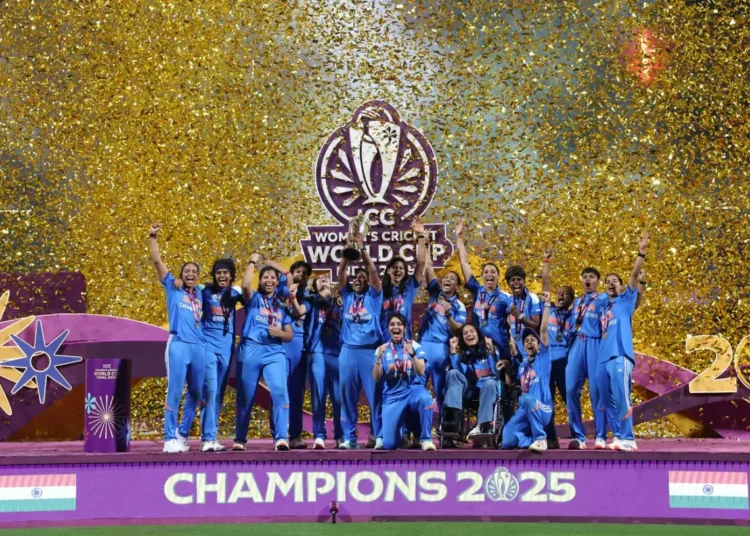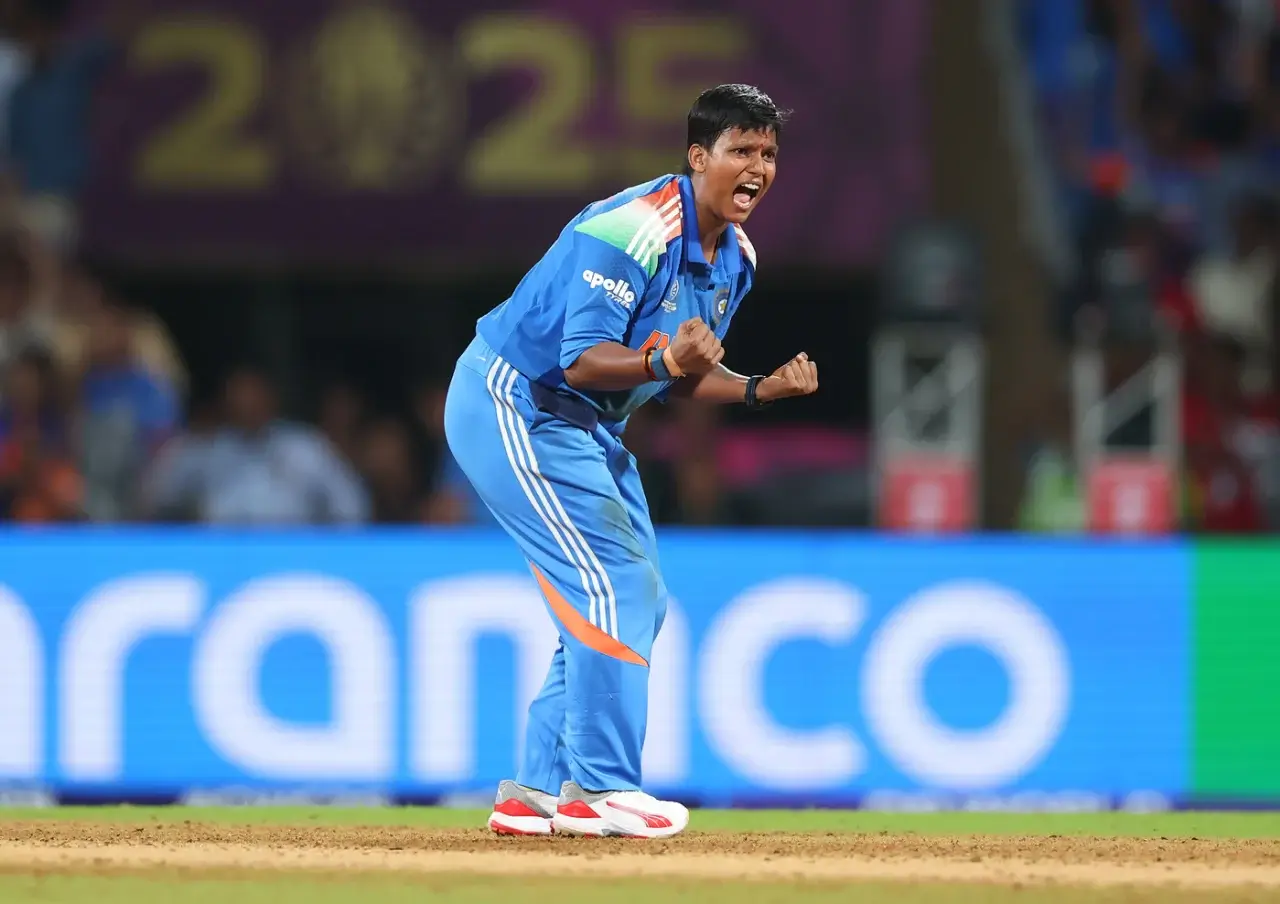At 21 years and 278 days, Shafali Verma became the face of India’s golden night. Her fearless batting, bold bowling, and unshakable self-belief carried India to their first-ever ICC Women’s World Cup title. Under the lights of Navi Mumbai’s DY Patil Stadium, her story unfolded like destiny — raw, emotional, and unfiltered.
When South Africa chased 299 in the final, India needed inspiration. Harmanpreet Kaur turned to Shafali, trusting the same energy that lit up her batting earlier in the day. She had already smashed 87 off 78 balls with aggression and control. Now, with the ball, she was about to script the twist that would define her career.
Shafali had bowled only 14 overs in her previous 30 ODIs. But on this night, she became India’s golden arm. Within two overs, she removed Sune Luus and Marizanne Kapp, breaking South Africa’s momentum. India eventually won by 52 runs, and Shafali became the youngest player to be named Player of the Match in an ODI World Cup final.
Her smile after the win said it all — no fear, no pressure, just purpose. The fearless 21-year-old had arrived not as the future, but as the present of Indian cricket.
The fearless knock that set the tone for India
Shafali’s batting was pure confidence wrapped in clarity. From the first over, she played like someone born for the stage. The pitch offered some movement, but she handled it with timing and fearless intent. Her drives through cover and flicks off the pads were crisp and clean, like India’s domination.
Alongside Smriti Mandhana, she built a 104-run partnership that silenced South Africa early. Their chemistry was calm yet attacking — Mandhana rotated the strike, while Shafali found the boundaries. Together, they gave India a start that defined the rhythm of the innings. By the time Shafali reached 87, she had already outscored half the opposition’s lineup.
Her strike rate never dipped below 110, and her shot selection was flawless. Even when cramps slowed her down, she didn’t lose intent. Every run reflected the maturity of a player who had grown beyond her years. This innings wasn’t just about skill; it was about character — young, fearless, and unshakably confident.
Youthful energy that inspired belief
Shafali’s batting changed the team’s mindset. Her aggression transferred to the dressing room and the crowd alike. For a team known for composure, she brought raw energy. This mix of calm leadership and fearless youth gave India balance. That’s how modern champions are made.
The over that changed the match
When South Africa’s chase began, India needed a breakthrough. Harmanpreet saw something special in Shafali’s confidence and handed her the ball. What happened next felt almost cinematic. With her second ball, she dismissed Sune Luus with a sharp return catch.
In her very next over, she got Marizanne Kapp caught down leg side. It was as if the ball obeyed her will. The energy in the stadium exploded as teammates surrounded her. A part-timer with one career wicket before the final had just turned match-winner.
That single decision — trusting youth under pressure — shifted the entire game. South Africa went from confident to cautious, and India’s spinners took charge. Shafali had done what few can in finals — she turned a hunch into history.
The golden arm moment that defined her career
Every champion has a moment that becomes their identity. For Shafali, it wasn’t her batting, but this one over. It showed the world her composure and her captain’s faith in her. That golden arm moment announced a star who thrives on pressure, not avoids it.
Deepti Sharma’s brilliance complements the youth revolution
While Shafali stole headlines, Deepti Sharma quietly built India’s foundation. Her 58 runs stabilized the innings after early wickets. Then she delivered one of the finest bowling spells in a World Cup final. Her 5 for 39 included the vital wicket of Laura Wolvaardt, who had scored 101.
Deepti became the first player in any ODI knockout — men’s or women’s — to score a fifty and take a five-wicket haul. She also finished the tournament with 215 runs and 22 wickets — a record all-round double. Her calm balance perfectly complemented Shafali’s fire.
Together, they represent India’s evolution — youth guided by experience, aggression managed by precision. This blend has become India’s biggest strength, a model of modern cricketing maturity.
Experience that fuels the next generation
Deepti’s calm nature makes her a natural mentor for younger stars like Shafali. She brings stability without slowing the game’s rhythm. Every successful team needs that equilibrium — and India found it through Deepti’s consistency.
The new face of Indian cricket — fearless, young, and united
India’s World Cup win marked more than a trophy; it marked a transformation. The team’s average age is among the youngest of all finalists. Richa Ghosh, Amanjot Kaur, Radha Yadav, and Jemimah Rodrigues represent a new generation shaped by confidence, not caution.
The energy of youth flows through every partnership and celebration. They play with joy, not fear. They make mistakes, but they recover fast. That’s the biggest cultural shift in Indian women’s cricket — belief replacing hesitation.
Harmanpreet’s leadership unlocked that spirit, allowing young players to express themselves freely. When Shafali says, “Seniors told me to play my natural game,” it reflects a dressing room built on freedom, not fear. That’s the real secret behind this historic win — fearless cricket played by fearless women.
The blueprint for India’s cricketing future
This team has shown that age is just a number. Performance matters more than experience. Their mix of youth and maturity will dominate global cricket for years. India didn’t just win a final — they built a future ready for every challenge.
Conclusion
The DY Patil night wasn’t just another win; it was the dawn of something new. India’s women showed that courage, trust, and talent can conquer history. At the heart of it was Shafali Verma — 21 years old, fearless, and unafraid to lead. Her 87 runs and two wickets defined the story of a generation.
Deepti Sharma added the calm, skill, and experience that completed the team’s arc. Harmanpreet Kaur’s leadership brought out the best in everyone. Together, they built India’s golden chapter — one that will inspire millions of young girls to dream louder.
From Smriti Mandhana’s grace to Amanjot Kaur’s catch, every moment mattered. But the biggest symbol was Shafali — standing tall with the trophy, smiling with a mix of disbelief and pride. It wasn’t about luck; it was about preparation, meeting courage.
The DY Patil Stadium witnessed a transformation — a fearless India ready to rule cricket’s biggest stages. The future isn’t coming; it’s already here, wearing number 17, and her name is Shafali Verma.







